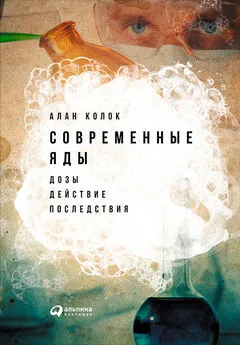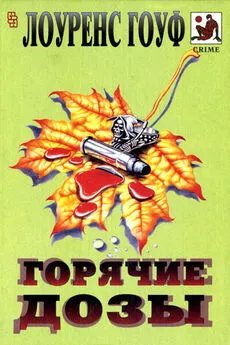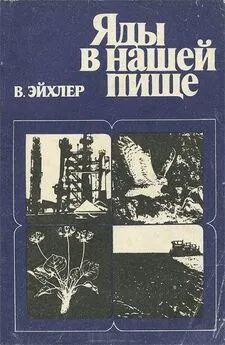Алан Колок - Современные яды: Дозы, действие, последствия
- Название:Современные яды: Дозы, действие, последствия
- Автор:
- Жанр:
- Издательство:Альпина Паблишер
- Год:2017
- Город:Москва
- ISBN:978-5-9614-4570-1
- Рейтинг:
- Избранное:Добавить в избранное
-
Отзывы:
-
Ваша оценка:
Алан Колок - Современные яды: Дозы, действие, последствия краткое содержание
Вы узнаете из книги о том, что происходит в мире токсикологии сейчас, как и для чего ученые разрабатывают всё новые смертоносные яды, под какими красивыми масками они нам преподносятся, как проникают в наш организм и какие последствия вызывают, и, конечно, о тех маленьких бездумных преступлениях против окружающей среды, которые мы ежедневно совершаем не задумываясь. Библиотека электронных книг и журналов
Современные яды: Дозы, действие, последствия - читать онлайн бесплатно ознакомительный отрывок
Интервал:
Закладка:
Dunlap, T. R. "Science as a Guide in Regulating Technology: The Case of DDT in the United States." Social Studies of Science 8 (1978): 265–85.
McWilliams, J. E. "'The Horizon Opened Up Very Greatly': Leland O. Howard and the Transition to Chemical Insecticides in the United States, 1894–1927." Agricultural History 82 (2008): 468–95.
O'Shaughnessy, P. T. (2008) "Parachuting Cats and Crushed Eggs: The Controversy over the Use of DDT to Control Malaria." American Journal of Public Health 98: 1940–48.
Smith, A. E., and D. M. Secoy. "Forerunners of Pesticides in Classical Greece and Rome." Journal of Agricultural and Food Chemistry 23 (1975): 1050–55.
Botting, J. «The History of Thalidomide.» Drug News & Perspectives 15 (2002): 604–11.
Gaughan, A. "Harvey Wiley, Theodore Roosevelt, and the Federal Regulation of Food and Drugs." Студенческая работа, Harvard Law School, 2004. http://nrs.harvard.edu/urn-3:HUL.InstRepos:8852144
Herbst, A. L., D. C. Poskanzer, S. J. Robboy, L. Friedlander, and R. E. Scully. "Prenatal Exposure to Stilbestrol: A Prospective Comparison of Exposed Female Offspring with Unexposed Controls." New England Journal of Medicine 292 (1975): 334–39.
Herbst, A. L., H. Ulfelder, and D. C. Poskanzer. "Adenocarcinoma of the Vagina." New England Journal of Medicine 284 (1971): 878–81.
Janssen, W. F. "The Story of the Laws behind the Labels." FDA Consumer. US Food and Drug Administration, 1981. http://www.fda.gov/AboutFDA/WhatWeDo/ History/Overviews/ucm056044.htm
Klimko, K. "FDA's Contradictory Decisions Related to the Delaney Clause." Студенческая работа, Harvard Law School, 2011. http://nrs.harvard.edu/urn-3: HUL.InstRepos:8963872
Neltner, T. G., N. R. Kulkarni, H. M. Alger, M. V. Maffini, E. D. Bongard, N. D. Fortin, and E. D. Olson. "Navigating the U. S. Food Additive Regulatory Program." Comprehensive Reviews in Food Science and Food Safety 10 (2011): 342–68.
Nicole, W. "Secret Ingredients: Who Knows What's in Your Food?" Environmental Health Perspectives 121 (2013): A126–33.
Quinn, R. "Rethinking Antibiotic Research and Development: World War II and the Penicillin Collaborative." American Journal of Public Health 103 (2013): 426–34.
US Food and Drug Administration. "Guidance for Industry: Frequently Asked Questions about GRAS." US Department of Health and Human Services, 2004. http://www.fda.gov/Food/GuidanceRegulation/ GuidanceDocumentsRegulatoryInformation/ IngredientsAdditiveGRASP-ackaging/ucm061846.htm
Wax, P. M. "Elixirs, Diluents, and the Passage of the 1938 Federal Food, Drug, and Cosmetic Act." Annals of Internal Medicine 122 (1995): 456–61.
Asch, P. «Food Safety Regulation: Is the Delaney Clause the Problem or Symptom?» Policy Sciences 23 (1990): 97–110.
Baker, M. "Insights from the Structure of Estrogen Receptor into the Evolution of Estrogens: Implications for Endocrine Disruption." Biochemical Pharmacology 82 (2011): 1–8.
Blair, R. M., H. Fang, W. S. Branham, B. S. Hass, S. L. Dial, C. L. Moland, W. Tong, L. Shi, R. Perkins, and D. M. Sheehan. "The Estrogen Receptor Binding Affinities of 188 Natural and Xenochemicals: Structural Diversity of Ligands." Toxicological Sciences 54 (2000): 138–53.
Creton, S., M. J. Aardema, P. L. Carmichael, J. S. Harvey, F. L. Martin, R. F. Newbold, M. R. O'Donovan, et al. "Cell Transformation Assays for Prediction of Carcinogenic Potential: State of the Science and Future Research Needs." Mutagenesis 27, no. 1 (Jan 2012): 93–101. doi:10.1093/mutage/ger053.
Fagan, D. "The Learning Curve." Nature 490 (25 October 2012): 462–65.
Junod, S. W. "Sugar: A Cautionary Tale." US Food and Drug Administration, 2003. http://www.fda.gov/aboutfda/whatwedo/history/ productregulation/selectionsfromfdliupdateserieson fdahistory/ucm091680.htmпо состоянию на 1 января 2016.
Levenson, A. S., and V. C. Jordan. "The First Hormone-Responsive Breast Cancer Cell Line." Cancer Research 57 (1997): 3071–78.
Melnick, R., G. Lucier, M. Wolfe, R. Hall, G. Stancel, G. Prins, M. Gallo, et al. "Summary of the National Toxicology Program's Report of the Endocrine Disruptors Low-Dose Peer Review." Environmental Health Perspectives 110 (2002): 427–31.
Vandenberg, L. N., T. Colborn, T. B. Hayes, J. J. Heindel, D. R. Jacobs Jr., D.-H. Lee, T. Shioda, et al. "Hormones and Endocrine-Disrupting Chemicals: Low-Dose Effects and Nonmonotonic Dose Responses." Endocrine Reviews 33 (2012): 1–78.
Welshons, W. V., K. A. Thayer, B. M. Judy, J. A. Taylor, E. M. Curran, and F. S. vom Saal. "Large Effects from Small Exposures: I. Mechanisms for Endocrine-Disrupting Chemicals with Estrogenic Activity." Environmental Health Perspectives 111 (2003): 994–1006.
Yager, J. D., and N. E. Davidson. "Estrogen Carcinogenesis in Breast Cancer." New England Journal of Medicine 354 (2006): 270–82.
Adeola, F. O. «Boon or Bane? The Environmental and Health Impacts of Persistent Organic Pollutants (POPs).» Human Ecology Review 11 (2004): 27–35.
American Chemical Society. "Rachel Carson's Silent Spring : National Historic Chemical Landmarks." American Chemical Society, 2013. http://www.acs.org/content/acs/en/education/ whatischemistry/landmarks/rachel-carson-silent-spring.html
Ballschmiter, K., R. Hackenberg, W. M. Jarman, and R. Looser. "Man-Made Chemicals Found in Remote Areas of the World: The Experimental Definition for POPs." Environmental Science & Pollution Research 9 (2002): 274–88.
Bard, S. M. "Global Transport of Anthropogenic Contaminants and the Consequences for the Arctic Marine Ecosystem." Marine Pollution Bulletin 38 (1999): 359–79.
Bonefeld-Jorgensen, E. C. "Biomonitoring in Greenland: Human Biomarkers of Exposure and Effects – A Short Review." Rural and Remote Health 10 (2010): 1362. http://www.rrh.org.au/articles/showarticlenew.asp?ArticleID=1362
Bowerman, W. W., D. A. Best, T. G. Grubb, G. M. Zimmerman, and J. P. Giesy. "Trends of Contaminants and Effects in Bald Eagles of the Great Lakes Basin." Environmental Monitoring and Assessment 53 (1998): 197–212.
Donaldson, S. G., J. Van Oostdam, C. Tikhonov, M. Feeley, B. Armstrong, P. Ayotte, O. Boucher, et al. "Environmental Contaminants and Human Health in the Canadian Arctic." Science of the Total Environment 408 (2010): 5165–234. doi:10.1016/j.scitotenv.2010.04.059. Epub 2010 Aug 21.
Boxall, A. B., M. A. Rudd, B. W. Brooks, D. J. Caldwell, K. Choi, S. Hickmann, E. Innes, et al. «Pharmaceuticals and Personal Care Products in the Environment: What Are the Big Questions?» Environmental Health Perspectives 120 (2012): 1221–29. doi:10.1289 / ehp.1104477. Epub 2012 May 30.
Brausch, J. M., and G. M. Rand. "A Review of Personal Care Products in the Aquatic Environment: Environmental Concentrations and Toxicity." Chemosphere 82 (2011): 1518–32.
Brooks, B. W. "Fish on Prozac (and Zoloft): Ten Years Later." Aquatic Toxicology 151 (2014): 61–67.
Brooks, B. W., C. K. Chambliss, J. K. Stanley, A. Ramirez, K. E. Banks, R. D. Johnson, and R. J. Lewis. "Determination of Select Antidepressants in Fish from an Effluent-Dominated Stream." Environmental Toxicology and Chemistry 24 (2005): 464–69.
Brooks, B. W., C. M. Foran, S. M. Richards, J. Weston, P. K. Turner, J. K. Stanley, K. R. Solomon, M. Slattery, and T. W. La Point. "Aquatic Ecotoxicology of Fluoxetine." Toxicology Letters 142 (2003): 169–83.
Brooks, B. W., P. K. Turner, J. K. Stanley, J. J. Weston, E. A. Glidewell, C. M. Foran, M. Slattery, T. W. La Point, and D. B. Huggett. "Waterborne and Sediment Toxicity of Fluoxetine to Select Organisms." Chemosphere 52 (2003): 135–42.
Fabbri, E. "Pharmaceuticals in the Environment: Expected and Unexpected Effects on Aquatic Fauna." Annals of the New York Academy of Sciences 1340 (2015): 20–28.
Gonzalez-Rey, M., N. Tapie, K. Le Menach, M.-H. Devier, H. Budzinski, and M. J. Bebianno. "Occurrence of Pharmaceutical Compounds and Pesticides in Aquatic Systems." Marine Pollution Bulletin 96 (2015): 384–400.
James-Todd, T., M. B. Terry, J. Rich-Edwards, A. Deierlein, and R. Senie. "Childhood Hair Product Use and Earlier Age at Menarche in a Racially Diverse Study Population: A Pilot Study." Annals of Epidemiology 21 (2011): 461–65. doi:10.1016 / j.annepidem.2011.01.009. Epub 2011 Mar 21.
Kessler, R. "More than Cosmetic Changes: Taking Stock of Personal Care Product Safety." Environmental Health Perspectives 123 (2015): A120–27. doi:10.1289 / ehp.123-A120.
Larsson, J. D. G., C. de Pedro, and N. Paxeus. "Effluent from Drug Manufactures Contain Extremely High Levels of Pharmaceuticals." Journal of Hazardous Materials 148 (2007): 751–55. Epub 2007 Jul 6.
Larsson, J. D. G. "Pollution from Drug Manufacturing: Review and Perspectives." Philosophical Transactions of the Royal Society B 369 (2014). doi:10.1098 / rstb.2013.0571.
Lubick, N. "India's Drug Problem." Nature 457 (2009): 640–41. doi:10.1038 / 457640a.
Matthiessen, P., and L. Weltje. "A Review of the Effects of Azole Compounds in Fish and Their Possible Involvement in Masculinization of Wild Fish Populations." Critical Reviews in Toxicology 45 (2015): 453–67. doi:10.3109 / 10408444.2015.1018409. Epub 2015 Apr 21.
Myers, S. L., C. Z. Yang, G. D. Bittner, K. L. Witt, R. R. Tice, and D. D. Baird. "Estrogenic and Anti-Estrogenic Activity of Off-the-Shelf Hair and Skin Care Products." Journal of Exposure Science and Environmental Epidemiology 25 (2015): 271–77. doi:10.1038 / jes.2014.32. Epub 2014 May 21.
Oaks, J. L., M. Gilbert, M. Z. Virani, R. T. Watson, C. U. Meteyer, B. A. Rideout, H. L. Shivaprasad, et al. "Diclofenac Residues as the Cause of Vulture Population Decline in Pakistan." Nature 427 (12 February 2004): 630–33.
Overturf, M. D., J. C. Anderson, Z. Pandelides, L. Beyger, and D. A. Holdway. "Pharmaceuticals and Personal Care Products: A Critical Review of the Impacts on Fish Reproduction." Critical Reviews in Toxicology 45 (2015): 469–91. doi:10.3109 / 10408444.2015.1038499. Epub 2015 May 6.
Sumpter, J. P., R. L. Donnachie, and A. C. Johnson. "The Apparently Very Variable Potency of the Anti-Depressant Fluoxetine." Aquatic Toxicology 151 (2014): 57–60.
Ternes, T. A., A. Joss, and H. Siegrist. "Scrutinizing Pharmaceuticals and Personal Care Products in Wastewater Treatment." Environmental Science & Technology 38 (2004): 392A – 399A.
Tiwary, C. M. "Premature Sexual Development in Children Following the Use of Estrogen– or Placenta-Containing Hair Products." Clinical Pediatrics 37 (1998): 733–39.
Wise, L. A., J. R. Palmer, D. Reich, Y. C. Cozier, and L. Rosenberg. "Hair Relaxer Use and Risk of Uterine Leiomyomata in African-American Women." American Journal of Epidemiology 175 (2012): 432–40. doi:10.1093 / aje / kwr351.
Barber, L. B., A. M. Vajda, C. Douville, D. O. Norris, and J. H. Writer. «Fish Endocrine Disruption Responses to a Major Wastewater Treatment Facility Upgrade.» Environmental Science & Technology 46 (2012): 2121–31.
Читать дальшеИнтервал:
Закладка:









